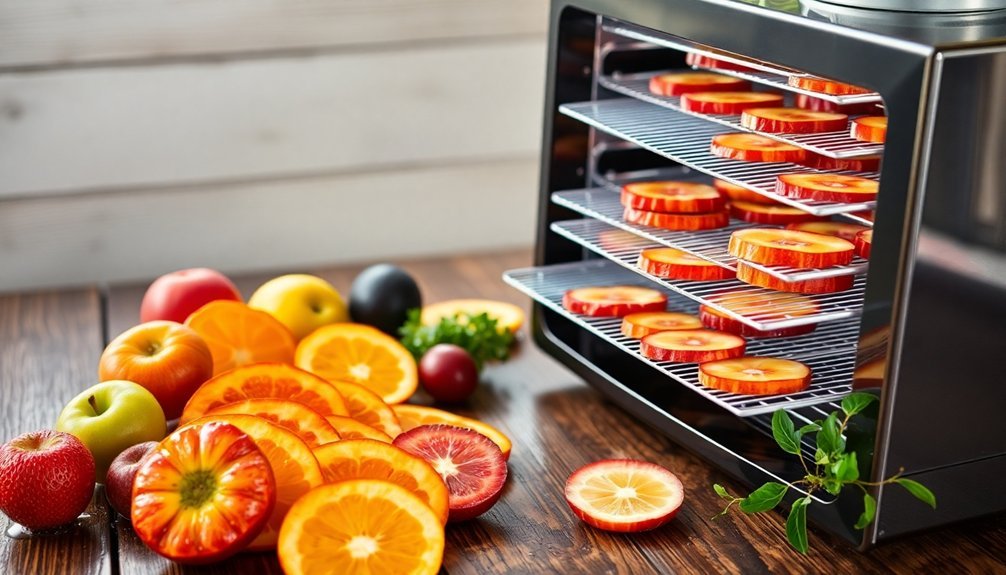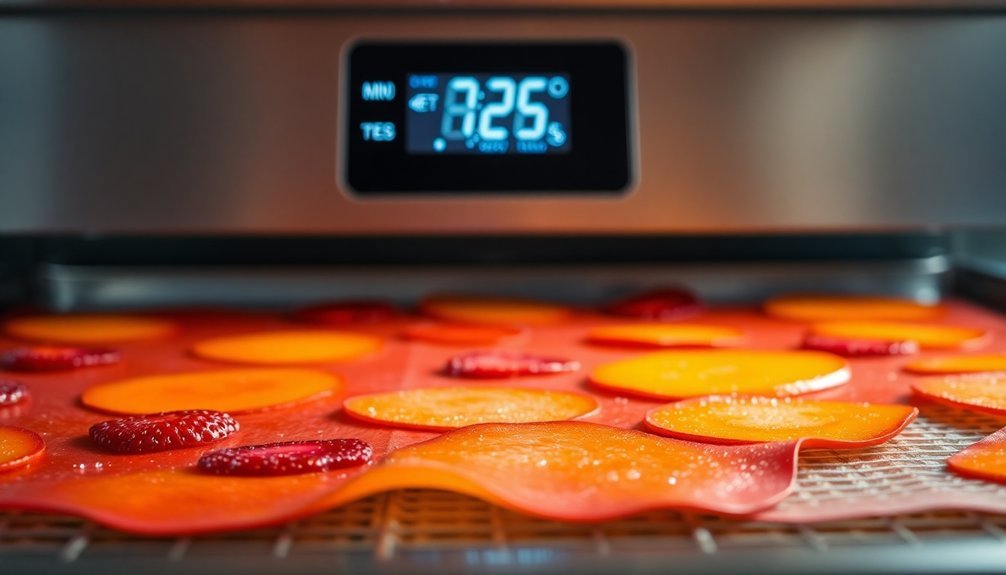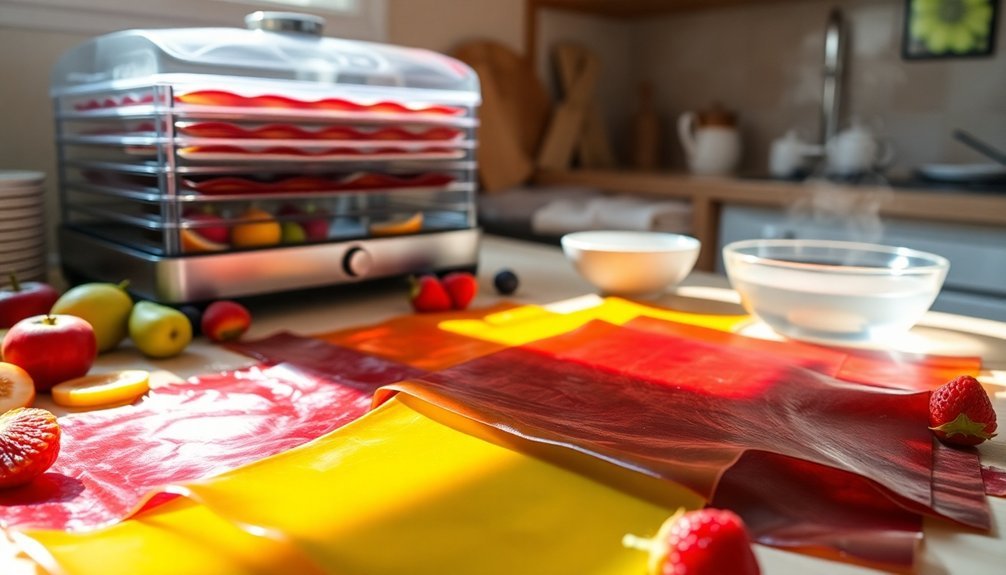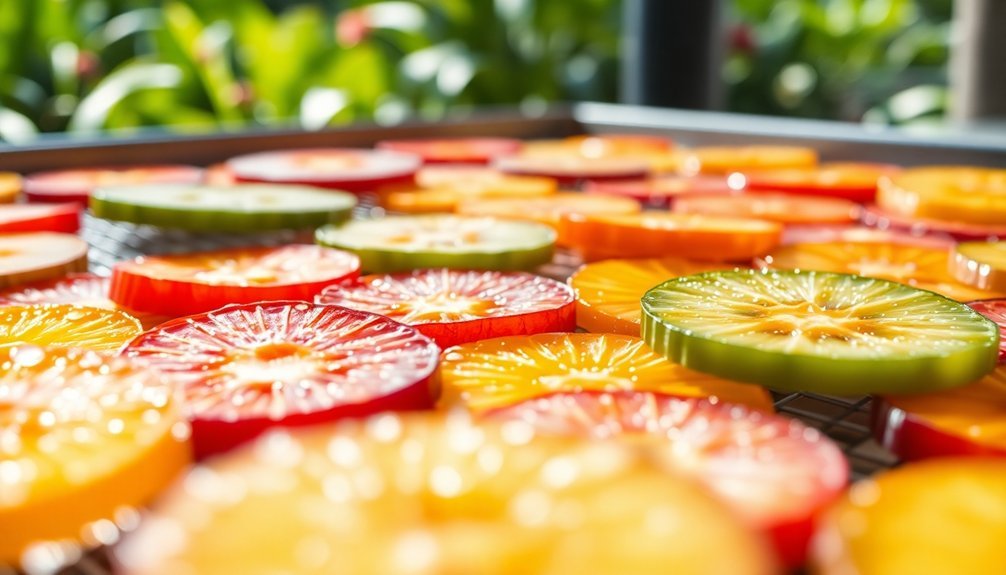To keep your fruit leather mold-free while dehydrating, start with ripe fruit and wash it well. Use lemon juice to prevent darkening. Set your dehydrator to 135-145°F and spread the puree evenly, about 1/8 to 1/4 inch thick. Rotate trays regularly for even drying and check for readiness after six hours. Store your leather in airtight containers, placing parchment paper between layers. Monitor for condensation daily and rehydrate if needed. With these tips, you'll guarantee a perfect texture and prevent mold. There's even more to learn about preserving your delicious fruit leather for extended enjoyment.
Preparing the Fruit and Dehydrator

To kick off your fruit leather journey, start by selecting ripe or slightly overripe fruit, which will yield the best flavor.
Wash your fruit in cool water, then remove any peels, seeds, and stems. Cut the fruit into manageable chunks and puree it until smooth using a blender or food processor. For light-colored fruits, add 2 teaspoons of lemon juice or 1/8 teaspoon of ascorbic acid for every two cups to prevent darkening. If you'd like, sweeteners like honey or maple syrup can enhance the flavor. Additionally, it's beneficial to combine high water content fruits with drier fruits to achieve the perfect texture.
Next, it's time to prepare your dehydrator. Line the trays with paraflexx sheets, parchment paper, or silpat—avoid wax paper, as it sticks. Set your dehydrator to a temperature between 135-145°F (57-63°C) for best drying.
Spread the fruit puree evenly across the lined trays, about 1/8 to 1/4 inch thick, using an offset spatula for an even layer. Rotate the trays periodically to promote even drying and restack them, moving previously top trays to the bottom.
This will help guarantee your fruit leather dries uniformly and is free from mold.
Preventing Uneven Drying
To prevent uneven drying, you need to start with a uniform layer of fruit puree, ideally about ⅛ to ¼ inch thick. Once you've got that down, rotate the trays during the dehydrating process to guarantee every piece gets the same heat exposure. This simple practice can make a big difference in the quality of your fruit leather. Additionally, using ripe fruit ensures the best flavor and texture in your final product.
Even Puree Distribution
Achieving even puree distribution is essential for preventing uneven drying when making fruit leather. To get it right, use an offset spatula for large or square trays, as it helps you spread the fruit puree evenly. For smaller or round trays, an angled pie server works perfectly. Aim for a thickness of about 1/8 to 1/4 inch (2-5 mm). Keeping the puree slightly thicker in the center can counteract faster drying around the edges.
Make certain to leave at least an inch border from the edge of the tray to allow for spreading during the drying process. Before you start, line your dehydrator trays with paraflexx sheets, parchment paper, or silicone mats, avoiding wax paper as it sticks badly to the fruit leather. Using ripe or overripe fruit helps ensure a thicker puree consistency, which is crucial for even drying.
As the leather dries from the edges inward, check for dryness by gently touching the center—there should be no indentation or sticky spots. If you find certain areas still thick and sticky, reconsider your puree distribution next time.
Keeping an eye on these details guarantees your fruit leather dries evenly and stays delicious!
Regular Tray Rotation
How can you guarantee your fruit leather dries evenly? Regular tray rotation is vital for preventing uneven drying. By rotating your trays every 2-3 hours, you can make certain of consistent moisture distribution throughout the dehydrator. Remember, trays in the center often dry slower than those on the top or bottom, so adjusting their positions is essential.
Here's a simple rotation schedule to follow:
| Time Interval | Tray Position Adjustment | Notes |
|---|---|---|
| 0-2 hours | Top to bottom | Start with trays in center |
| 2-4 hours | Bottom to top | Move center trays up |
| 4-6 hours | Rotate all trays | Ensure even heat exposure |
| 6-8 hours | Center trays to edges | Check for moisture spots |
| 8+ hours | Final check | Ensure pliability |
Keep an eye out for thick, sticky portions in the middle. If you notice uneven drying, adjust tray positions based on the dryness of your fruit leather. This meticulous approach will lead to a pliable, uniform final product, preventing any dark spots or brittleness that can affect your delicious fruit leather.
Monitoring and Maintaining Dryness

Maintaining your fruit leather's dryness is essential for preventing mold and guaranteeing a delicious final product. Start checking the dryness at the 6-hour mark to guarantee even drying. Use flat fingers to press the leather; if you see an indentation or dark, wet spots, it's not ready.
Rotate your trays halfway through the drying time if one side seems to be drying faster than the other.
Look for flexibility and dryness to the touch. The leather should feel slightly tacky but have no sticky patches. The edges should be dry, possibly a bit crispy, indicating progress. It should peel off easily from the dehydrator sheet without breaking or sticking.
Aim for a drying temperature of 135-145°F (57-63°C) to prevent mold growth. Drying times can vary from 6 to 10 hours, so if it's still damp after the initial drying time, keep dehydrating. It's better to over-dry than under-dry to avoid spoilage.
If you accidentally over-dry, you can rehydrate it with a damp towel or turn it into powder for other recipes. Regular monitoring is key to achieving the perfect fruit leather.
Conditioning to Prevent Mold
To keep your fruit leather mold-free, start by placing it in a jar with a tight-fitting lid.
Store the jar in a dark cupboard and check it daily for any signs of condensation.
If you spot moisture, you'll need to re-dehydrate the fruit leather to guarantee it stays dry and safe.
Jar Storage Method
Proper jar storage is essential for keeping your fruit leather mold-free during the conditioning process. Start by guaranteeing your fruit leather is completely dry and flexible, with no sticky patches. Cut it into portions for easier handling and even drying.
Place the servings in a jar with a tight-fitting lid, making sure it's airtight to maintain low moisture levels inside. Store the jar in a dark cupboard for about a week. During this time, monitor the jar for any signs of excess moisture, such as condensation. If you notice any, return the fruit leather to the dehydrator for 15-30 minutes to dry it out further.
Be sure to let it cool completely before putting it back into the jar. To prevent moisture issues, avoid storing the fruit leather in environments with high humidity or temperature fluctuations. Using parchment paper between layers can help prevent sticking and moisture transfer.
Regularly check the stored fruit leather for signs of mold or unusual odors. Following these steps will help guarantee your fruit leather stays fresh and delicious throughout the conditioning period.
Daily Condensation Checks
After you've stored your fruit leather in a tightly sealed jar, daily condensation checks become important to confirm it stays mold-free. Each day, you need to inspect the jar for any signs of condensation. This simple process helps make sure that your fruit leather remains dry and safe from mold.
Here's what you should do:
- Check for condensation: Look for moisture on the jar's walls or lid. If you see any, it means the fruit leather isn't dry enough.
- Remove and re-dehydrate: If there's condensation, take the fruit leather out and return it to the dehydrator for an extra 15-30 minutes.
- Cool before storing: After re-drying, let the fruit leather cool completely before putting it back in the jar.
- Repeat checks: Continue this process until you observe no condensation during your daily checks.
Keeping an eye on condensation not only prevents mold but also guarantees your fruit leather stays delicious and safe to eat.
Rehydrating Brittle Fruit Leather

Brittle fruit leather can be revived with a few simple techniques that restore its pliability. One effective method is to use a damp towel. Place it next to the brittle leather, allowing it to reabsorb moisture without direct contact.
Alternatively, you can spray the fruit leather evenly with a fine mist of water and let it rest for a few minutes. Repeat this process until it becomes pliable.
For a more thorough rehydration, break the leather into small pieces and cover them with boiling water. Soak for 10-15 minutes, using about 1/2 cup of water for every cup of leather bits. Remember to allow the leather to gradually soak up moisture to prevent wet spots that could lead to mold.
To avoid future brittleness, monitor drying time closely. Check your fruit leather around the 6-hour mark and verify it's dry but not overly brittle.
Also, spread the fruit puree to a thickness of about ⅛ to ¼ inch and adjust drying time based on humidity levels. By following these techniques, you can enjoy your fruit leather's chewy goodness once again!
Storage and Maintenance
To keep your fruit leather fresh and mold-free, it's essential to store it correctly right after dehydration. Start by conditioning your fruit leather to guarantee even moisture.
Place your servings in a glass jar with a tight-fitting lid, storing it in a cool, dark cupboard. Check daily for condensation, and if you see any, re-dry it for 15-30 minutes in the dehydrator.
For ideal storage, follow these tips:
- Use Airtight Containers: Glass jars and zip-top bags are excellent for protecting against moisture and contaminants.
- Separate Layers: Use plastic wrap or parchment paper to prevent sticking, but avoid wax paper as it clings to the fruit leather.
- Cool, Dry Location: Store your fruit leather at room temperature for short periods or refrigerate it for up to a month.
- Freeze for Longevity: Wrap tightly in plastic and place in a freezer bag to extend its shelf life up to a year.
Frequently Asked Questions
Can I Mix Different Fruits for Fruit Leather?
Yes, you can mix different fruits for fruit leather! Combining berries with stone fruits or tropical fruits with apples enhances flavor, texture, and moisture balance, creating a deliciously unique leather that everyone will love.
How Do I Know When My Dehydrator Is Working Correctly?
You'll know your dehydrator's working correctly when it beeps to signal it's on, shows cycling temperature and time, and the trays dry evenly. Check for dryness regularly and verify no overlapping food.
Is It Safe to Dehydrate Frozen Fruit?
Yes, it's safe to dehydrate frozen fruit, but you need to thaw and wash it first. Proper handling minimizes bacterial risks, so always guarantee cleanliness during preparation for the best results.
What Are the Best Fruits for Making Leather?
When making fruit leather, you'll love using berries like strawberries and blueberries, stone fruits like peaches and plums, or tropical options like mangoes and pineapples. They all blend well for delicious, flavorful results!
Can I Add Sweeteners or Spices to My Fruit Leather?
Yes, you can definitely add sweeteners or spices to your fruit leather. Experiment with natural sweeteners like honey or maple syrup, and enhance flavors with spices like cinnamon or nutmeg for a unique twist. Enjoy!
In Summary
By following these tips, you'll keep your fruit leather mold-free and delicious. Proper preparation, even drying, and careful conditioning are key to preventing any unwanted growth. Don't forget to store your leather in a cool, dry place to maintain its quality. With a little attention to detail, you can enjoy your homemade treats without the worry of mold. So, get ready to savor your tasty fruit leather for weeks to come!





Leave a Reply